How to Crochet for Beginners
What is Crochet?
Crochet is a craft technique that involves using a hooked needle to create fabric by interlocking loops of yarn or thread. It is similar to knitting, but instead of using two needles, crochet uses a single hook. With crochet, you can create a wide variety of items such as blankets, scarves, hats, and even intricate lacework. It's a popular hobby enjoyed by many people around the world. The options are endless! We’ve compiled a step-by-step easy-to-follow guide to help you learn to crochet with some helpful tips along the way!
What do I need to begin crocheting?
One of the best things about crocheting is that you don't need a lot to get started – you can get by with just two things:
However, having access to additional tools can make things easier. Let's get a little more detailed and then you'll be able to decide what's right for you.
Choose your yarn
Choosing the right yarn for your project will ensure that your finished product looks and feels the way you want it to. Yarn comes in different weights, colors, and fibers. You can find more information on the different yarn weights in our yarn weight comparison post coming soon! Beginners may find it easier to start with medium weight yarn in a light color. This will make it easier to see your stitches and correct any mishaps along the way.
We recommend starting with Basic Stitch Anti Pilling™ Yarn or similar.
Choose your hook
Crochet hooks come in different sizes and materials such as metal, plastic, bamboo, and wood. The size of the hook you choose will depend on the weight of the yarn you’re using and the desired gauge. If you aren't sure which size you need, it's usually a good idea to check the yarn label – it should display the recommended size.
Additional tools
These may not be required for every project, but it's usually a good idea to have these handy to make the job easier:
- Scissors – a pair of sharp scissors will come in handy for cutting yarn and trimming loose ends
- Yarn needles – these are used for weaving in loose ends and sewing pieces together
- Stitch markers – these are helpful for marking specific stitches or sections in your work
- Measuring tape – a flexible measuring tape is useful for checking gauge and measuring your work
- Other accessories – some crafts enjoy using a yarn bowl or bag to keep their yarn organized, and a stitch counter to help keep track of their stitches
Now that you have your materials - let’s crochet! Here you’ll find a handy step by step guide that you can refer back to at any time! Remember - it will take some time to learn. Mistakes are okay – they are a part of the process.
A Step-by-Step Guide to Crochet
How to Hold Your Crochet Hook
When holding a crochet hook, there are 2 widely used methods. You can hold the hook however feels most comfortable to you!
Method 1 - The Pencil Grip

In the pencil method, place your thumb on the flat part of the hook, near the thumb rest or grip area. Rest the hook against the side of your index finger, with the pointed end facing down. Curl your remaining fingers gently around the hook, just like you would when holding a pencil.
Method 2 - The Knife Grip
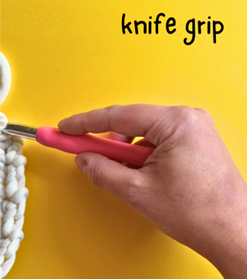
In the knife method, place your right hand over the hook and grasp it between your thumb and index finger to begin. The left hand is used to control the yarn and to hold the stitches as they are created.
Remember to find a grip that feels comfortable for you. Ultimately, the goal is to find a grip that allows you to manipulate the hook smoothly and maintain control while working on your crochet project. Practice and experimentation will help you determine the most comfortable and efficient method for you.
How to Hold Yarn When Crocheting
It's important to learn how to hold your yarn because of tension. Tension is important in crochet because it affects the overall appearance and size of your project. When you crochet with consistent tension, it ensures that your stitches are uniform in size and appearance. This is especially important when working on projects that require precise measurements.
Hold your non-dominant hand out in front of you, face down. Bring the initial strand of yarn under your pinky, ring finger, or middle finger. Then wrap it over your pointer finger. Control the tension by squeezing your fingers together as you work a stitch and pull more yarn into your project. When you squeeze, you'll add more tension and your stitches will be smaller. Less squeezing results in a lower tension and more loose stitching.
How to Make a Slip Knot
To begin, you'll need to make the first loop on your hook, a slip knot.
To make a slipknot:Make a loop with your yarn, be sure to leave a tail long enough to weave in later! Then bring the tail of the yarn over the loop and insert it into the loop from underneath. Pull the tail to tighten the knot.
 |
 |
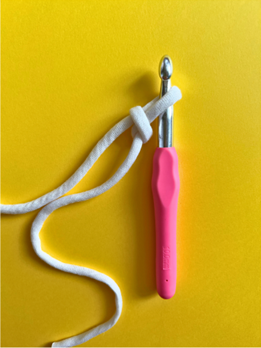 |
 |
How to Make a Chain Stitch
Our next task is to create a starting chain, which serves as the foundation for the entire crochet project.
 |
 |
- Hold the short tail of slipknot in your left hand and the hook in your right hand
- Yarn over (bring the yarn over the hook from back to front) and pull it through the loop on the hook. This creates a new loop on the hook, which is your first chain stitch.
Continue making chain stitches, moving your left hand along the chain creating some tension, until you have the desired number for your project.
It can take time and practice to keep these stitches consistent - don’t give up! Keep practicing and you will see your consistency improve over time.
Counting the Chains

The photo above shows how to count the chain stitches you have worked. When counting chains, do not include the slip knot at the end or the loop on your hook as a stitch.
Work your first stitch in between the V’s of each chain stitch. Shown below:

The first row of crochet can be challenging for beginners, and working into chain stitches can be particularly tricky. It's a common struggle for new crocheters, but with some practice and guidance, it becomes easier.
Here are some tips to help you navigate the first row of crochet:
- Take your time: Crocheting is a skill that improves with practice. Be patient with yourself and give yourself the time to learn and make mistakes.
- Use a larger hook: When starting a new project, you can use a hook that is one or two sizes larger than the one recommended for the yarn you're using. This will create larger chain stitches, making it easier to work into them on the first row.
- Properly tension the yarn: Make sure your yarn tension is consistent. You don't want your chain stitches to be too tight or too loose, as it will affect how easy it is to work into them.
- Practice with a foundation chain: Before starting your actual project, practice making a foundation chain on its own. This will give you a chance to get comfortable with creating chain stitches and help you figure out where to insert your hook.
- Mark your stitches: Consider using stitch markers or contrasting yarn to mark the first stitch of each row. This will help you keep track of where your rows begin and prevent any confusion.
- Count your stitches: Counting your stitches as you go will help you ensure that you haven't accidentally skipped or added any stitches.
- Try alternative methods: Some crocheters find it easier to start with a foundation single crochet (FSC) or a foundation half double crochet (FHDC) instead of the traditional chain stitches. These techniques provide a more solid base to work into.
- Utilize video tutorials and diagrams: Sometimes, seeing the process in action can be incredibly helpful. Look for video tutorials or crochet diagrams that demonstrate how to work into chain stitches for the first row.
- Use a stable surface: If you find it hard to hold the fabric while crocheting into the chain, place your work on a stable surface like a table or lap desk to provide support.
Remember, practice makes perfect, and it's normal to encounter challenges when you're starting. Don't be discouraged by the initial difficulties; keep trying, and soon you'll find yourself more comfortable with crocheting into chain stitches.
Each crochet stitch has 2 loops on the top of the stitch. The photo below identifies these loops. Usually, you will insert your hook under both loops of the stitch in the previous row. Sometimes, to create a decorative effect, a pattern will indicate to work in either the front loop or back loop of a stitch.

All About Stitches
How to Single Crochet (SC)
The single crochet is one of the basic crochet stitches, and it's often one of the first stitches that beginners learn. Once you've created a foundation chain, you can start working single crochet stitches into it to build your fabric. Here's a step-by-step guide on how to make a single crochet:
- Insert your hook: Take your crochet hook and insert it into the desired stitch of the foundation chain. The first stitch is usually the second chain from the hook, but it can vary depending on the pattern.
- Yarn over: Once your hook is inserted, wrap the yarn over the hook from back to front, moving in a counter-clockwise direction.
- Pull through: Draw the wrapped yarn through the stitch. Now, you should have two loops on your hook.
- Yarn over and pull through both loops: Wrap the yarn over the hook again and pull it through both loops on the hook. This completes one single crochet stitch.
- Continue across the row: Repeat steps 1 to 4 for each stitch in the foundation chain until you reach the end of the row.
- Turning chain: When you reach the end of the row, you'll need to turn your work to start the next row. To do this, chain one (or as many as required by the pattern) and turn your work.
- Single crochet in each stitch: Insert your hook into the first stitch of the new row, yarn over, pull through the stitch, yarn over, and pull through both loops on the hook. Continue making single crochet stitches across the row.
- Repeat: Repeat step 7 for each row, making a turning chain at the end of each row, until your project reaches the desired length.
Tips:
- Remember to keep your tension consistent to create even stitches
- Count your stitches at the end of each row to ensure you haven't missed or added any stitches
- The last stitch of each row can be a bit tricky to identify. Pay attention to the top of the turning chain from the previous row, and make sure to work into it
Practicing the single crochet stitch will help you become more comfortable with crocheting, and you'll be ready to explore other stitches and more complex projects in no time!
 |
 |
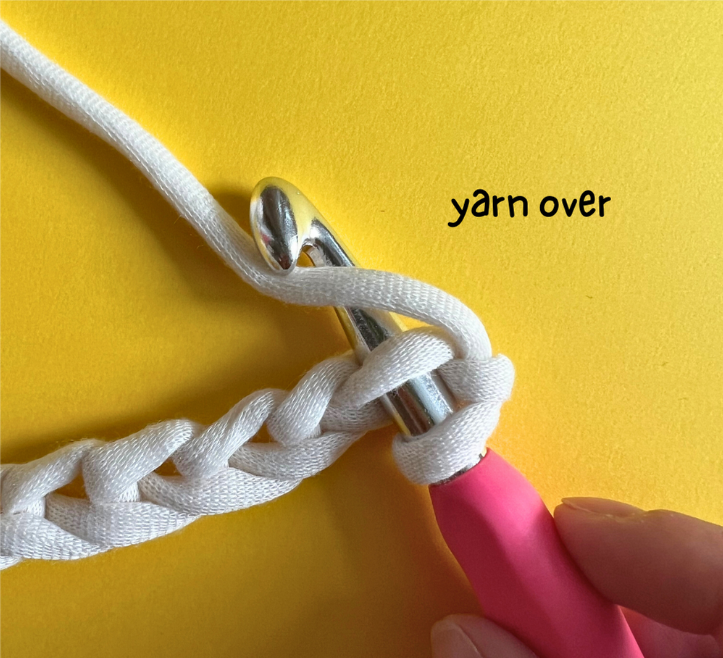 |
 |
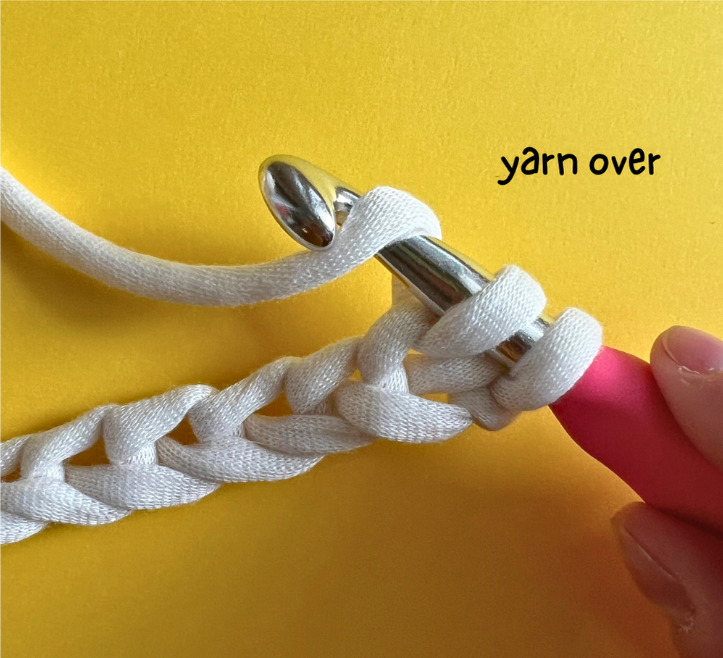 |
 |
How to Double Crochet (DC)
The double crochet (abbreviated as "dc") is another fundamental crochet stitch and is taller than the single crochet. It's commonly used in various crochet projects and can create a more open and airy fabric. Here's a step-by-step guide on how to make a double crochet:
- Yarn over and insert your hook: Yarn over by wrapping the yarn from back to front around your hook, moving in a counter-clockwise direction. Then, insert your hook into the desired stitch of your foundation chain or previous row.
- Yarn over and pull through: Yarn over again and pull it through the stitch you inserted your hook into. Now, you should have three loops on your hook.
- Yarn over and pull through two loops: Yarn over once more and pull it through the first two loops on your hook. You should have two loops remaining on the hook.
- Yarn over and pull through the last two loops: Yarn over one final time and pull it through the remaining two loops on your hook. This completes one double crochet stitch.
- Continue across the row: Repeat steps 1 to 4 for each stitch in the foundation chain or the previous row until you reach the end.
- Turning chain: To start the next row, you'll need to create a turning chain. For double crochet, typically chain three at the end of the row and turn your work.
- Double crochet in each stitch: Starting in the second stitch from the hook (the first stitch is where you made the turning chain), yarn over, insert your hook, and work a double crochet following steps 2 to 4. Continue making double crochet stitches across the row.
- Repeat: Repeat step 7 for each row, making a turning chain of three at the end of each row, until your project reaches the desired length.
Tips:
- Maintain consistent tension throughout your work to achieve even and nicely shaped stitches.
- Count your stitches at the end of each row to ensure accuracy and avoid mistakes.
With practice, you'll become more familiar with the double crochet stitch and be able to incorporate it into various crochet patterns and designs. Happy crocheting!
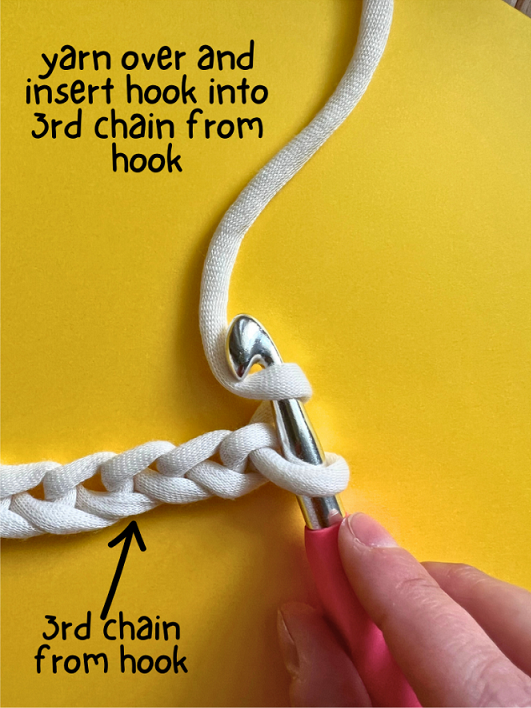 |
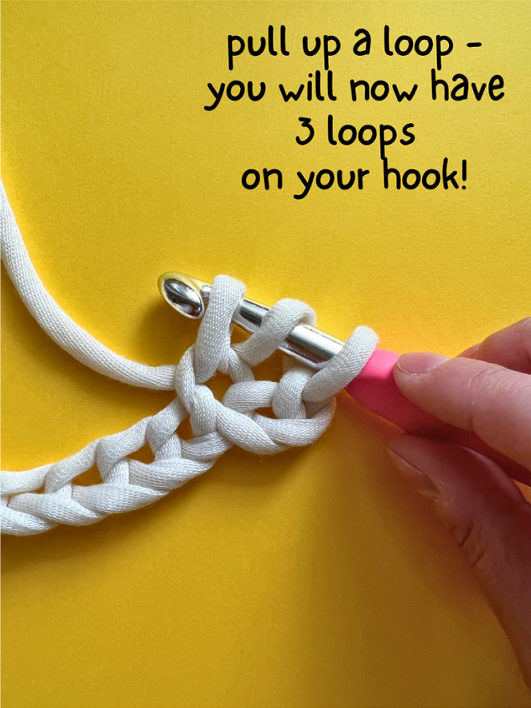 |
 |
 |
 |
 |
Finishing
Properly finishing your crochet work ensures that it looks neat and professional. Here are the common steps to finish your crochet project:
- Fasten off: When you've reached the end of your project, you'll need to fasten off the yarn to secure it. To do this, cut the yarn, leaving a tail of about 6 inches (15 cm) or more. Yarn over and pull the yarn tail through the loop on your hook. This will create a knot to secure the last stitch.
- Weave in ends: After fastening off, you'll have yarn tails at the beginning and end of your work. Use a yarn needle or crochet hook to weave these tails back and forth into the stitches on the backside of your project. This hides the ends and ensures they won't come undone over time.
- Block your project (optional): Blocking is the process of shaping and sizing your crochet project. Depending on the type of yarn and project, you might want to block it to make the stitches more even and the project lay flat. You can steam block, wet block, or use special blocking tools, depending on the fiber and pattern used.
- Add any embellishments (optional): If your project requires buttons, zippers, or other embellishments, now is the time to attach them securely.
- Finish off decorative edges (optional): For projects with decorative edges, like blankets or shawls, you might need to add a border. Choose your desired border pattern and follow the instructions to complete it.
- Wash and block (optional): If you haven't already blocked your project, you can wash it following the yarn's care instructions and then block it to ensure the final shape and size.
- Enjoy your finished project: Once you've completed all the necessary finishing touches, your crochet project is ready to use or give as a gift!
 |
 |
 |
 |
Remember, the finishing steps may vary depending on the type of project you're working on and the specific pattern you've used. Always follow the pattern's finishing instructions if you're following a crochet pattern.
Finishing your crochet project carefully and with attention to detail can make a significant difference in the final appearance of your work. So take your time and enjoy the satisfaction of completing your crochet masterpiece!
More Crochet Techniques
Check out our Stitch Finder for hundreds of crochet and knit stitch patterns, trims, motifs, and decorative elements! Each one includes detailed instructions on how to create them.
Crochet Pattern Terms and Abbreviations
Did you encounter an unfamiliar term when reading a pattern? We've got you covered! Check out our glossary for a comprehensive breakdown of every term you might find when reading a crochet pattern.
